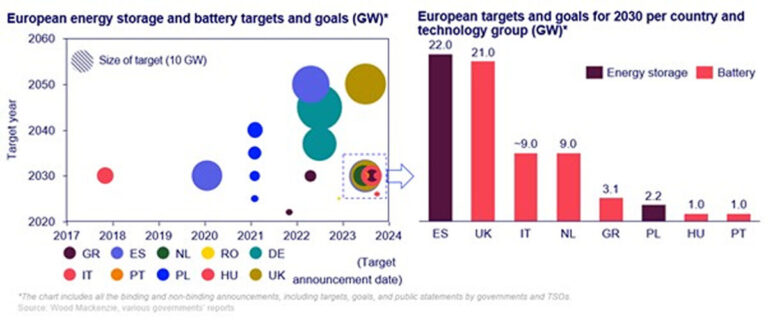Europe has been slow to recognize the role of energy storage devices in energy markets. Current market conditions, in terms of frequent oversupply, increasing numbers of zero and low energy prices, have all highlighted the limits of flexibility in the region.
This limitation has now been recognized by the European government. More and more governments and transmission system operators (TSOs) are recognizing the crucial role of energy storage by including energy storage targets in their National Energy and Climate Plans (NECPs) and national energy plans.
As a result of current market conditions, the sector sees the emergence of a more diversified European energy storage market. Developers are shifting interest from Britain to other European countries, where the urgent need for flexible resources is evident.
However, which market besides the target group always comes down to the accessibility of the available revenue streams – both sellers and contracts. While in some markets seller income remains safe and sound, in other markets all eyes are on the next available storage-friendly auctions – in other words, contracted income.
Take Germany, for example, which has recently been dubbed the new United Kingdom in grid-scale storage. Here, the energy storage market will pass a total of 15 GW by 2033, compared to 1.4 GW today. Increasing demand in this country is driven by existing energy trading opportunities, supplemented by revenues from ancillary markets and emerging balancing services. In other words, Germany promises healthy lifelong merchant incomes.
It’s a different story in Italy, where all players are waiting for the result MACSE tender or the upcoming capacity market auction. Italy has set the highest energy storage target in Europe, installing 71 GWh by 2030. To help achieve this goal, Terna has decided to take the regulated approach by offering developers fixed-fee contracts for 12 to 14 years to offer. for lithium-ion batteries and up to 30 years for pumped hydroelectric power stations. MACSE conditions will harm competition between technologies, players and market prices.
Meanwhile, in Greece, the government held two tenders for energy storage in October 2023 and February 2024. Oversubscribed storage tenders show that the active players in this country are rushing for contracted revenues. Interestingly, the tender results show that the awarded capacity with the lowest bid prices could in fact have earned more if the market became purely commercial.
So the shift in the European market for grid-scale storage is clear, and new opportunities are emerging. Different European countries offer different types of support mechanisms in terms of contracted revenues, in the form of capacity markets, storage tenders or PPA contracts, depending on existing regulations and available financing. The European Commission has called the existing mechanisms inadequate and has proposed the introduction of a Europe-wide flexibility support scheme.
(Graphs 1 and 2 show the dominant type of support schemes available in Europe and the allocated capacity by country and auction type).
Only since 2020, 16 GW of reduced battery capacity has been awarded in various European auctions, which will come online in the next three to five years. But this is just the beginning: more than €2.5 billion is expected to be invested in different types of storage auctions and tenders, highlighting the role of energy storage as a flexible resource.


